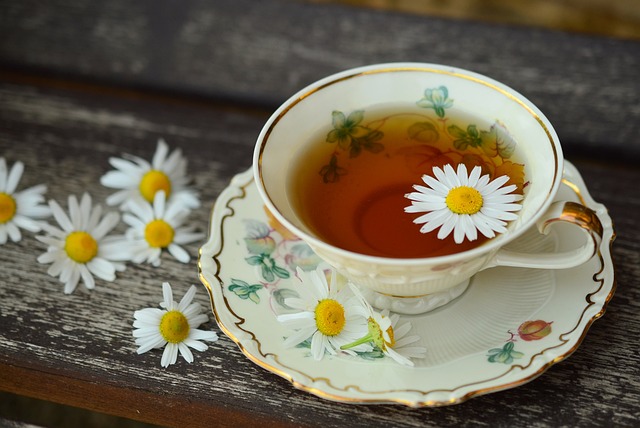
Image Source: Pexels
## Introduction to Hibiscus Tea and its Benefits for High Blood Pressure
Hibiscus tea has long been revered for its numerous health benefits, and one of its most impressive uses is as a natural remedy for high blood pressure. High blood pressure, also known as hypertension, affects millions of people worldwide and can lead to serious health complications if left untreated. Fortunately, hibiscus tea offers a natural and effective way to manage this condition.
Hibiscus tea is derived from the vibrant flowers of the hibiscus plant, scientifically known as Hibiscus sabdariffa. This tea is rich in antioxidants, specifically anthocyanins, which have been shown to help lower blood pressure levels. Additionally, hibiscus tea contains compounds that act as diuretics, promoting the excretion of excess fluid from the body and reducing blood volume. These combined effects make hibiscus tea a powerful ally in the battle against high blood pressure.
Understanding High Blood Pressure and its Impact on Health
Before delving into the science behind hibiscus tea’s effectiveness in lowering blood pressure, it is crucial to understand the significance of high blood pressure and its impact on overall health. High blood pressure occurs when the force exerted by blood against the walls of the arteries is consistently too high. This places strain on the heart and blood vessels, increasing the risk of heart disease, stroke, and other cardiovascular complications.
Managing high blood pressure is essential for maintaining good health and preventing these serious conditions. Lifestyle modifications, such as a healthy diet, regular exercise, and stress reduction, play a vital role in blood pressure management. However, incorporating natural remedies like hibiscus tea can provide an additional boost in controlling blood pressure levels.
The Science Behind Hibiscus Tea’s Effectiveness in Lowering Blood Pressure
The effectiveness of hibiscus tea in lowering blood pressure has been extensively studied, and the results are compelling. Several scientific studies have demonstrated that the regular consumption of hibiscus tea can lead to a significant reduction in blood pressure levels.
One study published in the Journal of Human Hypertension found that participants who consumed hibiscus tea experienced a notable decrease in both systolic and diastolic blood pressure. Another study conducted by the American Heart Association revealed that hibiscus tea had a similar effect to certain blood pressure medications, further solidifying its reputation as a natural remedy for hypertension.
The key behind hibiscus tea’s blood pressure-lowering properties lies in its ability to inhibit an enzyme called angiotensin-converting enzyme (ACE). ACE plays a crucial role in regulating blood pressure by constricting blood vessels. By inhibiting this enzyme, hibiscus tea helps to relax and dilate the blood vessels, promoting healthy blood flow and reducing blood pressure.
How to Make Hibiscus Tea for High Blood Pressure
Making hibiscus tea for high blood pressure is a simple and enjoyable process. Here’s a step-by-step guide to brewing your own cup of this natural remedy:
- Start by bringing water to a boil in a saucepan or kettle. For a single serving of hibiscus tea, use one cup of water.
- Once the water reaches a rolling boil, remove it from heat and add two teaspoons of dried hibiscus flowers or one tea bag to the saucepan.
- Cover the saucepan and let the hibiscus steep for about 5-10 minutes. The longer you steep, the stronger the flavor will be.
- After steeping, strain the tea to remove the hibiscus flowers or tea bag.
- If desired, sweeten the tea with a natural sweetener like honey or stevia.
- Pour the hibiscus tea into a cup and enjoy it while it’s still warm.
By following these simple steps, you can easily incorporate hibiscus tea into your daily routine and reap its blood pressure-lowering benefits.
The Best Herbal Teas for High Blood Pressure
While hibiscus tea is undoubtedly a top contender in the realm of herbal teas for high blood pressure, there are other options worth exploring. Here are some of the best herbal teas that can complement hibiscus tea in managing blood pressure:
Chamomile Tea
Chamomile tea is renowned for its calming properties and is often used to promote relaxation and reduce anxiety. It can also help lower blood pressure due to its mild diuretic effect. By promoting the excretion of excess fluid, chamomile tea supports healthy blood pressure levels.
Green Tea
Green tea is a powerhouse of antioxidants, including catechins, which have been linked to numerous health benefits. Some studies suggest that green tea consumption may help reduce blood pressure levels. However, it is important to note that green tea contains caffeine, which can affect blood pressure in some individuals. If you are sensitive to caffeine, opt for decaffeinated green tea instead.
Ginger Tea
Ginger has long been used for its medicinal properties, and ginger tea is no exception. It possesses anti-inflammatory and antioxidant properties that can potentially lower blood pressure. Additionally, ginger tea may help improve blood circulation, further supporting cardiovascular health.
Incorporating these herbal teas into your routine alongside hibiscus tea can provide a well-rounded approach to managing high blood pressure naturally.
Exploring Other Types of Tea That Can Help Lower Blood Pressure
While herbal teas are the go-to options for managing high blood pressure, other types of tea can also offer benefits in blood pressure control. Let’s explore some of these alternatives:
Black Tea
Black tea, like green tea, is rich in antioxidants known as flavonoids. These compounds have been associated with lower blood pressure levels. However, it’s worth noting that black tea contains more caffeine than green tea, so moderation is key, especially for those sensitive to caffeine.
Rooibos Tea
Rooibos tea, also known as red tea, is a caffeine-free herbal tea that boasts a wealth of health benefits. It contains flavonoids and other antioxidants that may help reduce blood pressure. Additionally, rooibos tea is naturally sweet and can be enjoyed without the need for added sugars.
Oolong Tea
Oolong tea is a traditional Chinese tea that falls somewhere between green and black tea in terms of oxidation. Like its counterparts, oolong tea contains antioxidants that may contribute to blood pressure regulation. Its unique flavor profile makes it a delightful addition to any tea collection.
By exploring these different types of tea, you can find the ones that suit your taste preferences while promoting healthy blood pressure levels.
Incorporating Hibiscus Tea into a Healthy Lifestyle for Blood Pressure Management
While hibiscus tea can be a powerful natural remedy for high blood pressure on its own, incorporating it into a healthy lifestyle can further enhance its effects. Here are some tips for integrating hibiscus tea into your daily routine:
- Drink hibiscus tea regularly: Aim to consume at least two cups of hibiscus tea per day to maximize its blood pressure-lowering benefits.
- Maintain a balanced diet: Pair your hibiscus tea with a diet rich in fruits, vegetables, whole grains, and lean proteins. Avoid excessive sodium intake, as sodium can contribute to high blood pressure.
- Engage in regular physical activity: Exercise is crucial for managing blood pressure. Incorporate activities like brisk walking, cycling, or swimming into your routine.
- Manage stress levels: Chronic stress can elevate blood pressure. Practice stress-reducing techniques like meditation, deep breathing exercises, or yoga to promote relaxation.
- Limit alcohol consumption: Excessive alcohol intake can raise blood pressure. If you choose to drink, do so in moderation.
- Consult with your healthcare provider: If you have high blood pressure or are on any medications, consult with your healthcare provider before incorporating hibiscus tea or any other herbal remedies into your routine.
By combining these lifestyle modifications with the regular consumption of hibiscus tea, you can create a holistic approach to blood pressure management.
Chinese Tea and its Role in Managing High Blood Pressure
Chinese tea has a rich history and is renowned for its health benefits. Several types of Chinese tea, such as green tea, white tea, and pu-erh tea, have been associated with lower blood pressure levels. The polyphenols present in these teas have been shown to promote healthy blood pressure regulation.
Green tea, in particular, contains high levels of catechins, which possess antioxidant and anti-inflammatory properties. These compounds may help relax blood vessels, resulting in lower blood pressure. White tea, known for its delicate flavor, also contains beneficial polyphenols that support cardiovascular health. Pu-erh tea, a fermented tea, has been traditionally used in Chinese medicine to promote digestion and cardiovascular health.
Incorporating Chinese tea into your tea-drinking repertoire can be a delightful way to manage high blood pressure while exploring new flavors and traditions.
Choosing the Best Hibiscus Tea for High Blood Pressure
When selecting hibiscus tea for managing high blood pressure, it is essential to choose a high-quality product that is free from additives or contaminants. Here are some tips for choosing the best hibiscus tea:
- Look for organic certification: Opt for organic hibiscus tea to ensure it is free from pesticides or other harmful chemicals.
- Check the ingredient list: Read the label carefully to ensure that the tea contains only pure hibiscus flowers without any additional ingredients or flavorings.
- Consider loose-leaf tea: Loose-leaf hibiscus tea often provides a higher quality product compared to tea bags. The larger leaves of loose-leaf tea allow for better flavor extraction.
- Read customer reviews: Before making a purchase, read reviews from other customers to get an idea of the tea’s taste, quality, and effectiveness in managing blood pressure.
By taking these factors into consideration, you can find a high-quality hibiscus tea that delivers the maximum health benefits.
Conclusion and Final Thoughts on Using Hibiscus Tea as a Natural Remedy for High Blood Pressure
In conclusion, hibiscus tea is a powerful natural remedy for high blood pressure. Its ability to lower blood pressure levels, coupled with its delicious taste, makes it an excellent addition to any health-conscious individual’s routine. Alongside other herbal teas and lifestyle modifications, hibiscus tea can play a significant role in managing high blood pressure naturally.
Remember to consult with your healthcare provider before incorporating hibiscus tea or any other herbal remedies into your routine, especially if you have an existing medical condition or are on medication. With the right approach and a cup of hibiscus tea in hand, you can unlock the power of nature in your journey towards optimal blood pressure and overall well-being.
Unlock the Power of Hibiscus Tea: A Natural Remedy for High Blood Pressure


